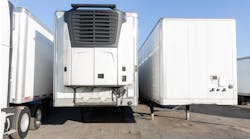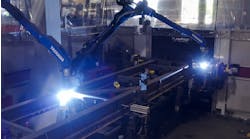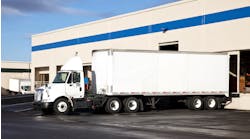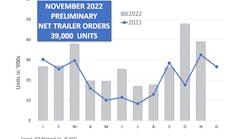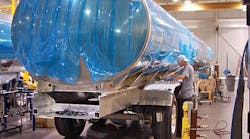THE 25 largest truck-trailer manufacturers in North America (plus three runners-up) produced 291,506 complete trailers in calendar year 2014. This is 20 percent more than the same trailer builders produced in 2013 and a new record for the 21st century.
However, it is not an all-time record. That honor belongs to the year 1999, when the 25-plus manufacturers built 301,864 trailers and another 37,849 container chassis, for a total of almost 340,000 complete trailers.
Almost all (22 of the 28 companies participating) reported increased production in 2014. These ranged from a high of 53% increase and several with 45% increases. Ten companies exceeded the “industry average” of 20% increase. Only six companies reported no change or a decrease in numbers of trailers produced.
The three largest trailer manufacturers produced nearly half (49.6%) of the trailers built by the group of Top 25-plus. The ten largest companies built 86.5% of the trailers in this Top 25 study.
The trailer totals reported here cannot be compared directly with other domestic surveys that do not also include Canadian and Mexican assembly plants. This survey does not attempt to report on the many small manufacturing companies located throughout North America.
To view the most recent report, choose "Trailer Output" from the menu at the top left
This Trailer/Body Builders survey is made by telephoning a member of the management team at each manufacturing company. The ranking of the companies does not necessarily reflect their relative success in terms of profitability or revenue received, but only the number of trailers manufactured. The dollar value of a trailer can vary greatly depending on design, type of construction, materials used, and quality level.
Here is how the individual trailer manufacturers performed in 2014:
► Wabash National Corporation reported record net sales of $1.86 billion in 2014, a 13% increase over the previous year. In terms of trailers produced, Wabash reported 56,150 total trailers in 2014, an increase of 22%, plus another 1,600 non-trailer shipments (dollies and truck bodies).
The largest segment is dry freight van trailers. Wabash built 45,450 vans, an increase of 25% over 2013. Refrigerated trailers were down 6% to 3,300 reefers. Platforms increased 33% to 3,850 flats. Tank trailers were up 15% to 3,550 tanks. Not counted in the trailer total are 1,200 converter dollies, up 50%, and non-trailer truck tank bodies of 400, down 25%.
The last quarter of 2014 was exceptionally strong. Wabash shipped 15,750 trailers (annualized rate of 63,000), which was up 17% from the 2013 fourth quarter. This increased volume and a 2.8% increase in average selling prices, along with better product mix, led to a 41% increase in operating income for the quarter. For the year, Wabash reported operating income of $122.4 million, and operating income margin rose to 6.6%, equalizing its best margin ever.
“We look forward to 2015 with a healthy backlog of orders totaling $1.09 billion, an increase of 54% as compared to the prior year period,” said Dick Giromini, president and CEO. “This represents the highest level in more than a decade. The trailer demand forecast is well above replacement levels for a fourth consecutive year.
“Fleet age, customer profitability, used trailer values, regulatory compliance, and access to financing all support continued strong trailer demand and provide a favorable pricing environment within specific product lines,” Giromini concluded.
► Great Dane Limited Partnership produced 47,500 truck trailers in 2014, an eight percent increase over 2013.
“Great Dane saw its fifth consecutive year of increased output last year, and we expect more to come in 2015,” says Brandie Fuller, vice-president of marketing. “The general economy and key segments have created an ideal environment for our customers, and they in turn are investing in new equipment.”
► Utility Trailer Manufacturing Co celebrated its fourth record year in a row, building 40,893 trailers, a 6% increase over 2013. More than half of these were refrigerated trailers—specifically, 20,949 reefers, an 8% increase over the previous year. This is the 20th year in which Utility Trailer has built more than half of the refrigerated trailers produced in the United States.
Utility Trailer also celebrated a record year building dry-freight vans. Their dry vans were up 2% to 17,177 trailers. Flatbeds and Tautliner curtain-side vans were up by 13% to 2,787 trailers.
With backlogs at their highest point ever, Craig Bennett, senior vice-president sales and marketing, is predicting another outstanding year in 2015. The big challenge now, he says, is hiring and training people.
► Hyundai Translead built 38,251 truck-trailers in 2014, an increase of 38% over 2013. Dry van trailers were up 28% to 31,231, and refrigerated vans were also up 28% to 2,502 reefers. However, platform trailers were down 55% to 138 flatbeds.
The biggest increase at Hyundai Translead was in the intermodal area. Production of container chassis more than tripled. The company produced 4,380 chassis last year, up 328%. Hyundai also built 700 domestic containers, a 35% increase. Converter dolly production reached 1,011 units, up 19% from 2013. These last two categories, containers and dollies, are not counted in the trailer total number.
Total Hyundai units produced in 2014 stands at 39,962, an increase of 38%, says Brett Bartels, deputy general manager, sales and marketing strategy. He credits a large part of the increase to the dealer network getting small orders as well as big fleet orders, and fleet expansions.
The company has 85 dealer locations in the U.S., Canada and Mexico. Production facilities are located in Tijuana, Mexico, and corporate headquarters are just across the border in San Diego, California.
► Vanguard National Trailer Corp is reporting for the second year both the container chassis produced by its parent company, CIMC USA, and the vans and reefers built by Vanguard National in Monon, Indiana.
Refrigerated vans assembled in the Monon plant increased 29% in 2014, totaling 1,936 reefers. Dry van production increased 13% to 9,758 trailers. Total van production—dry freight and reefers—was 11,694 complete trailers, a 16% increase.
Since the Monon plant has been at “maximum capacity” for the past two years, Charlie Mudd, Vanguard National president, says he doesn’t see how they can squeeze out an increase in 2015, but they always have.
CIMC Intermodal Equipment in South Gate, California, assembled 12,409 domestic container chassis, a 50% increase over 2013. Their ISO container chassis production was 4,271, up 369%—almost four times the number assembled in 2013. Total trailers and container chassis produced by Vanguard National and CIMC Intermodal increased 45% to 28,374 trailers/chassis in 2014.
► Stoughton Trailers LLC, Stoughton, Wisconsin, increased its overall unit output to 16,000 trailers in 2014, a 33% increase. This includes 13,000 dry freight van, grain and livestock trailers, and 3,000 container chassis. Stoughton also produced more than 450 storage containers that are not counted in the trailer total.
“We had a robust end to 2014. With a strong backlog, we look forward to continued overall company growth in 2015,” says Bob Wahlin, president.
Stoughton plans to produce more specialty vans in 2015. The company continues to improve a new production line focused on furniture vans, drop-frames, open tops, etc. Combined with the acquisition of Barrett Trailers in Oklahoma and the continued growth of the grain trailer market, Stoughton plans to further diversify their product offerings.
Stoughton also expects production increases in intermodal containers and chassis in 2015. “We are seeing higher demand for intermodal containers, which will help round out production from our Evansville facility where all our intermodal products are built,” says Wahlin.
► MANAC of Quebec built 7,500 truck-trailers in Canada and the United States, an increase of 14% over 2013. Vans, flatbeds, and specialty trailers were all good in Canada, as well as platform trailers built in the Oran, Missouri plant, and bottom dumps built in Kennett, Missouri.
Manac purchased the Peerless Limited plant in British Columbia in 2014. Six months of their production of forestry, logging, and heavy-haul trailers is also included in the total.
Charles Dutil, Manac president and CEO, sees another strong year in 2015, already under way.
► Fontaine Trailer Company of Birmingham, Alabama, had a great year, building 7,268 trailers, a new record and 36% more than in 2013. Most of these (90%) were platforms, and less than 10% were heavy-haul lowbeds.
Most of the platform markets were up—automotive, construction, home-building, freight haulers, says Hank Prochazka, president of the Fontaine Trailer Commercial Group. With a strong backlog, he believes 2015 will be “Robust—an even better year”.
► Heil Trailer International of Athens, Tennessee, had a fantastic year, building 4,900 trailers, a 53% increase. This includes 1,500 petroleum trailers, a 36% increase, but crude oil tank trailers were down somewhat (13%) to 700 trailers. Dry bulk trailers, also used in the oilfield industry for hauling frac sand, had a huge increase, more than doubling. Heil built 1,800 of these pneumatic trailers, a 225% increase.
Heil re-entered the stainless steel tank market this past year and built 100 of these stainless tank trailers as part of the production at its new plant in Juarez, Mexico. (See August, 2014 issue of Trailer/Body Builders, pages 16-20).
Production of lowbed and heavy hauler trailers at Heil Trailer’s Kalyn Siebert facility in Gatesville, Texas, increased 60% to 800 trailers.
“The outlook for 2015 is favorable for petroleum and high-cube dry bulk trailers,” says Jay Morfitt, director of strategic planning and marketing. “However, small-cube dry bulk and crude oil trailers that are used in the oil/natural gas services will be impacted by the price of oil.”
► Timpte Inc in David City, Nebraska, built 4,239 grain trailers in 2014, a 15% increase and their all-time biggest year building bulk commodity trailers. It was also a record year for corn production, even though the price dipped briefly below $3.50 per bushel, and ethanol demand remained good.
Dale Jones, president of Timpte, thinks that production in 2015 may be off a little from the record year in 2014. However, the company is continuing to expand. In May Timpte will open a new 12,000-sq-ft sales, parts, and service branch in Sioux Falls, South Dakota. It will be the company’s 12th branch. The company opened another full-service branch last year in Bloomington, Illinois.
► MAC Trailer Manufacturing of Alliance, Ohio, built 4,200 truck-trailers, a 19% increase over 2013. “Our overall increase in production is due mostly to the strong demand of the oil and gas industry,” says Mike Conny, president. “All four segments of our product lines, dumps, flats, tanks, and refuse transfer trailers, look very strong moving into the coming year.”
MAC Trailer recently started producing aluminum trailers in Billings, Montana, and Oklahoma City. “With this added capacity, we feel we should build well over 5,000 trailers this year.”
► Strick Corporation built 3,800 trailers in 2014, a nine percent increase over the preceding year. Almost half of these (1,800) were sheet-and-post van trailers built in the company’s plant in Monroe, Indiana. Another 1,800 were Cheetah container chassis built in Berwick, Pennsylvania. Strick’s Evans plant in Sumter, South Carolina, built 200 platforms and forestry trailers.
Ben Katz, marketing manager, says that quote and ordering activity continues strong in the new year, and he expects 2015 will total out about the same.
► Pitts Enterprises in Pittsview, Alabama, increased output 44%, building 3,312 trailers in 2014. This includes a wide variety of platforms including high flats, drop-frame, extendible, and oilfield platforms from the Dorsey plant in Elba. Logging trailers, forestry equipment and lowbeds are produced in the Pitts plant in Pittsview.
Jeffrey Pitts, CEO, says they are expecting the good market conditions and sales momentum to carry through in 2015.
► Reitnouer Inc in Birdsboro, Pennsylvania, (Reading area) built 3,020 aluminum platform trailers in 2014, a one percent increase. These include flats and drop-deck platforms. All use the Reitnouer bolted, all-aluminum design.
“We had a terrible first quarter,” says Bud Reitnouer, president. “We were down the first part of January moving into our new plant, and then we were hit by ice and snow storms. But we built 1,800 platforms in the last half of the year, and now we have increased the rate to 80 trailers a week.”
Now with the platform market improving and a real solid order back-log, Reitnouer is expecting to build 3,600 aluminum platforms in 2015. One possible problem with that plan may be driver shortages at fleet customers, he says.
► Con-way Manufacturing (formerly Road Systems Inc) produced 2,933 trailers in 2014, a 2% increase. Half of these were all-new manufacture and half were refurbished. Half were short doubles trailers (1,463) and half were long vans (1,470). Almost all (98%) were built for its parent company, Con-way Inc.
Lynn Reinbolt, president of Con-way Manufacturing, predicted a year ago that 2014 production would be a carbon copy of 2013. He missed that precise mark by an increase of 56 trailers over the 2013 number. His 2015 prediction is again the same as last year.
“We are enjoying stability of production at a high level.”
► East Manufacturing Company in Randolph, Ohio, built 2,735 truck-trailers in 2014, a 21% increase. This includes 1,113 all-aluminum platforms, 1,259 end dump trailers (including 56 steel models), and 363 aluminum refuse transfer trailers.
“Our backlog is the highest ever in the 46-year history of the company”, says David de Poincy, president. “We are booked to August.”
To fill that demand, East is expanding the plant and the product line. A new 70,000 sq ft building will be ready in September to build steel end dumps. Some of these will have a steel body on an aluminum frame.
With this expansion, East Manufacturing is expecting to see a 25% increase in trailer numbers in 2015.
► Polar Tank Trailer of Holdingford, Minnesota, built 2,500 tank trailers, the same number as in 2013.
“Frac sand trailers were very strong last year, and so were crude oil tank trailers,“ says Mark Hunsley, vice-president of sales and marketing. “However, both will be down in 2015, in line with the lower price of crude oil. But Polar has a very diversified product line that helps to buffer the cycles in individual product lines.”
The outlook for 2015 is about the same number, says Hunsley, but it would have been 10% to 20% higher without the decline in oil.
► Trail King Industries in Mitchell, South Dakota, and West Fargo, North Dakota, built 2,300 truck trailers, a 10% increase over 2013. In addition, the company continued its long history of building light-duty tag trailers using axles with an individual capacity of less than 10,000 lb. Production in 2014 was 450 of these light-duty tag trailers, up 276%.
Trail King is widely known for its lowbeds and heavy-haul trailers, but the stand-out in 2014 was its all-aluminum dry bulk pneumatic trailer. This is continuing into 2015.
“We are forecasting a 10% increase in 2015,” says Gene Astolfi, CFO. “However, we recognize the risk if crude oil prices continue to decline.”
► Doepker Industries in Anaheim, Saskatchewan, Canada, built 1,800 truck-trailers in 2014, a 13% increase over 2013. About 60% of these are grain and commodity bulk haulers for the agriculture market. The rest are for the oilfield market, logging trailers, platforms, and gravel haulers.
Doepker’s newest trailer is also its best-selling model. It is a Super B-train ag bulker on 10 axles, with three axles on the lead trailer and two axles on the rear trailer. With a tare weight of 19,500 lb, the 62-ft long combination carries a payload of 45 metric tones (99,000 lb). First introduced as a steel model, the all-aluminum version went into production in 2014 and now accounts for about half of Doepker’s bulk ag trailers.
With a strong market continuing in all five of Doepker’s trailer sectors, the company goal is 2000 trailers in 2015, says Devin Leonard, sales and marketing manager. After hitting the 2014 prediction on the head, odds are they will make it.
► Western Trailer in Boise, Idaho, had a tremendous year, increasing production 45% and turning out 1,405 trailers. “Production was very even throughout the year and evenly split between flatbeds and bulk products,” says Todd Swanstrom, engineering manager. He believes 2015 will continue at that same level, and total out very close to 2014.
► Tremcar Inc has three tank trailer plants located in Montreal and Toronto, Canada, and Strasburg, Ohio. It has now increased its US holdings with the purchase of Boston Steel Tank and Manufacturing in Malden, Massachusetts.
The combined 2014 production total is 1,525 tanks. The three Tremcar plants built 1,385 tank trailers, down 7.5%, and Boston Tank turned out 140 tank trucks in the nine months of Tremcar ownership. The new acquisition gives Tremcar a sales outlet in New England, and also a second tank repair facility and parts source in the United States.
Going forward, Daniel Tremblay, president of Tremcar, sees a tough year for crude oil transports, but dry bulk trailers, also used in the oil and gas industry for hauling fracking sand, may benefit from more cement transport in the improving construction industry.
► Kentucky Trailer in Louisville, Kentucky, had a really good year, better than average, reports Larry Roy, executive vice-president. However, the total trailer numbers don’t show it because of the mix of specialty trailer types. The official count is 1,284 trailers, down by 80 trailers or 6% off from 2013.
Kentucky Trailer is the largest manufacturer of specialized drop-frame vans for the household goods moving industry. A subsidiary company, Kentucky High Performance Trailers, finishes out Kentucky vans for mobile medical centers, on-site broadcast booths, and sporting events. Kentucky also acquired a competitor, Advanced Mobility, to expand its reach into the mobile medical market.
With its backlog up significantly, Kentucky is forecasting a bigger year in 2015, predicting about a 10% increase in trailers built.
► Felling Trailers in Saux Centre, Minnesota, built 1,106 heavy-duty truck trailers in 2014, an 11.5% decline from the previous year. The company also produced 3,160 light-duty tag trailers, a 33% increase.
Felling had predicted a somewhat flat year for their heavy-duty lines after back-to-back increases of almost 50% for each of the previous two years. Patrick Jennissen, vp-sales/marketing, says the decline last year was due to lower demand in Canada because of the lower Canadian dollar. He says the company is forecasting a modest 8% increase in 2015.
► Towmaster Trailers in Litchfield, Minnesota, built 1,024 heavy-duty trailers from flatbeds to heavy-haul lowbeds. This was a 14% increase over 2013 production. The increase in light-duty tag trailers was even greater—-up 20% year over year. The company built 2,975 light-duty utility trailers in 2014, and also 150 truck bodies. These two categories are not counted in the heavy-duty trailer total.
Chris Pokornowski, national sales manager for Towmaster Trailers, says the company is projecting a 10-12% increase in 2015. To meet the increasing demand, the company has started a three-phase construction program that will eventually add 50,000 square feet to the present 160,000-sq-ft facility. Phase one currently under way will help boost the output speed of the finishing department.
► Travis Trailers of Houston, Texas, built 797 trailers in 2014, an increase of 9% over 2013. These were principally aluminum end dumps, but also included bottom dumps and refuse transfer trailers. It included 17 trailers built and shipped to Honolulu, Hawaii.
“Our sales were limited by our ability to produce,” says C. K. (Bud) Hughes, president. To remedy that handicap, Travis is now undergoing a building program that will expand its footprint by fifty percent. The first phase is a new 70-ft by 330-ft rig-out building for completion of aluminum trailers. That will be followed by a 100 by 150-ft building.
“We have the biggest backlog in our history,” says Hughes, which leads him to predict a sales increase of 18% to 20% in 2015.
► Doonan Specialized Trailer in Great Bend, Kansas, built 776 trailers in 2014, down 32 units or 4% from the previous year. This includes both Doonan steel heavy-duty trailers and Chaparral aluminum platforms.
“Our oilfield equipment slowed down in the last half of the year,” Mike Gordy, president, said during the first week in January. “Now in 2015, our backlog is strong and we are booked to the second quarter.”
► Talbert Manufacturing in Rensselaer, Indiana, built 754 trailers in 2014, a 3% increase. The slow-down in oilfield activity is affecting most lowboy builders. Talbert has 16 different models or weight categories of 35-ton to 85-ton hydraulic detachable gooseneck lowbed trailers. One of the more popular is the 55-ton hydraulic detachable gooseneck low-deck trailer that Talbert introduced a year ago.
The outlook for 2015 is a little better, says Greg Smith, vice-president of sales and marketing. Talbert purchased Ferree Trailer on October 1, 2014, and will be building some Ferree models and some Talbert models in Ferree’s modern 60,000-sq-ft plant in Liberty, North Carolina (near Greensboro). ♦


